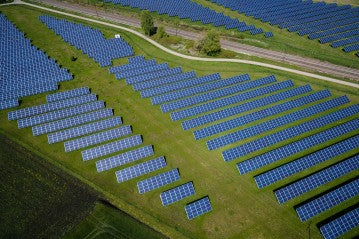
As the world shifts towards a more sustainable future, the adoption of solar energy systems has become increasingly prevalent. Among the remarkable innovations in this field, solar battery backup systems have emerged as a game-changer. These systems combine the benefits of solar power generation with efficient energy storage, providing customers with a reliable and sustainable source of electricity. In this blog post, we will unravel the mechanics of solar battery backup systems, exploring their components, operation, and the key considerations to keep in mind when making a purchase.
The Basics of Solar Battery Backup Systems
Before diving into the intricacies of solar battery backup systems, let's start with the basics. Solar panels, which harness the sun's energy through photovoltaic cells, are at the heart of these systems. The energy generated by the panels is then stored in a battery bank, ensuring a steady supply of power even when the sun goes down or during grid outages. This intelligent integration of solar panels and battery storage sets solar battery backup systems apart, offering numerous advantages and versatile applications.
Components of a Solar Battery Backup System
To comprehend how these systems work, it's essential to familiarize ourselves with their key components:
1. Solar Panels: These panels absorb sunlight and convert it into electricity through photovoltaic cells. Depending on the specific requirements and available space, customers can choose from various types of solar panels, such as monocrystalline, polycrystalline, or thin-film.
2. Inverter/Charge Controller: Acting as the brain of the system, the inverter charge controller converts the direct current (DC) electricity generated by the solar panels into alternating current (AC) power used in our homes. It also manages the charging process of the battery bank, optimizing its performance.
3. Battery Bank: The battery bank stores excess energy generated by the solar panels for use during periods of low or no solar generation. Customers can select battery technologies like lithium-ion, lead-acid, or flow batteries, based on their specific needs and preferences.
4. Monitoring and Control Systems: These systems enable users to monitor energy generation, storage levels, and overall system performance. Advanced monitoring technologies, such as mobile apps and smart energy management platforms, provide real-time insights and control over energy usage.
How Solar Battery Backup Systems Operate?
Solar battery backup systems function seamlessly by following a series of interconnected steps:
1. Solar Power Generation: As sunlight strikes the solar panels, the photovoltaic cells convert it into DC electricity. This electricity can either be consumed in real-time or stored for future use.
2. Charging the Battery Bank: The inverter/charge controller regulates the energy flow from the solar panels, ensuring efficient charging of the battery bank. It utilizes charging modes and algorithms to maximize the battery's lifespan and performance.
3. Discharging the Battery Bank: During grid outages or when solar generation is insufficient, the battery bank powers the electrical loads. By intelligently managing the power distribution, critical appliances and devices receive priority, ensuring uninterrupted operation.
4. Switching between Grid and Battery Power: An automatic transfer switch (ATS) enables seamless transitions between the grid and battery power. In hybrid systems, excess solar power can be fed back to the electrical grid, further optimizing energy usage and potentially reducing electricity bills.
Key Considerations for Choosing a Solar Battery Backup System
To make an informed decision when purchasing a solar battery backup system, consider the following factors:
1. Load Assessment and Energy Usage Analysis: Assess your energy requirements and analyze historical energy usage to determine the optimal system size. This step ensures the system can adequately meet your electricity demands.
2. Sizing the System Components: Properly size the solar panels, inverter/charge controller, and battery bank to match the desired capacity and energy storage needs. This ensures optimal system performance and maximizes the return on investment.
3. Choosing the Right Battery Technology: Consider factors such as battery lifespan, depth of discharge, and maintenance requirements when selecting a battery technology. Lithium-ion batteries, for instance, are known for their longer lifespan and higher energy density.
4. Regulatory and Safety Compliance: Familiarize yourself with local regulations, permits, and safety guidelines to ensure compliance during installation and operation. Working with a reputable solar energy provider can help navigate these requirements.
Pros and Cons of Solar Battery Backup Systems
Solar battery backup systems offer several benefits:
1. Enhanced Energy Independence: By generating and storing your electricity, you reduce reliance on the electrical grid, increasing energy self-sufficiency and reducing vulnerability to power outages.
2. Lower Electricity Bills: With excess solar energy being stored and used during peak hours, customers can significantly reduce their reliance on grid-supplied electricity, leading to cost savings.
3. Environmental Sustainability: By utilizing clean and renewable solar energy, solar battery backup systems contribute to a greener planet, reducing carbon emissions and promoting a sustainable future.
However, it's important to consider a few challenges and limitations:
1. Initial Investment and Payback Period: The upfront cost of installing a solar battery backup system can be a significant investment. However, the long-term energy savings and potential incentives often offset the initial expense.
2. Maintenance and Replacement Costs: While solar panels generally require minimal maintenance, battery maintenance and eventual replacement can add to the overall cost of the system. It's crucial to factor in these expenses when evaluating the financial viability.
Conclusion
Solar battery backup systems epitomize the marriage between solar power generation and energy storage, offering customers a sustainable, reliable, and cost-effective energy solution. By understanding the components, operation, and key considerations, individuals and businesses can make informed decisions when investing in solar battery backup systems. Embracing this technology not only enhances energy independence and lowers electricity bills but also contributes to a greener and more sustainable future. So, why not harness the power of the sun and embark on a journey towards a brighter, more resilient tomorrow with solar battery backup systems?
Related articles: Choosing the Perfect Solar Battery for Your Panel System


0 comments